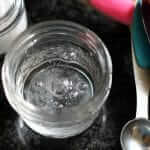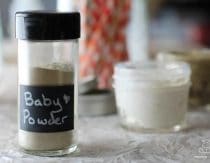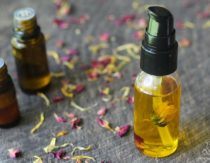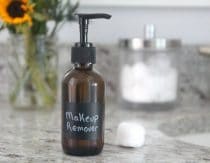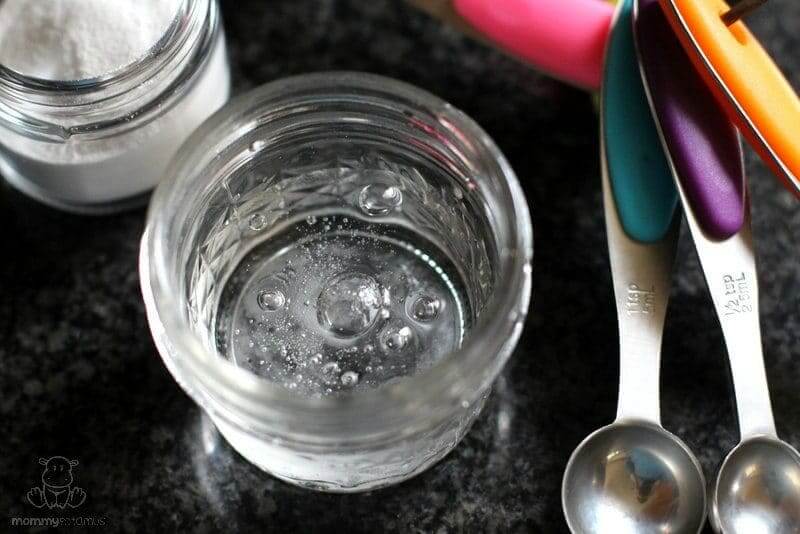
I eat skincare. Wait, that didn’t come out right. I mean skin food . . . or food for vibrant skin, like bone broth, gelatin, and naturally-derived vitamin C.
When it comes to supporting collagen production and skin elasticity, there’s no better approach than nourishing skin from within.
That’s because collagen – despite how often it’s used in face creams and serums to make them more marketable – can’t be absorbed via topical application. Collagen molecules are too large to penetrate the outer layer of skin, but you can provide your body with the basic building blocks to optimize its own production through food.
HOWEVER, that’s not to say that topical formulations can’t do amazing things for your skin.
Hyaluronic acid, for example, is what makes babies skin look so dewy and plump. Our skin makes less of it over time, but we can apply it topically to provide intense hydration. In this article I’ll share a super simple recipe for hyaluronic acid serum that you can incorporate into your skincare routine, but first you might be wondering . . .
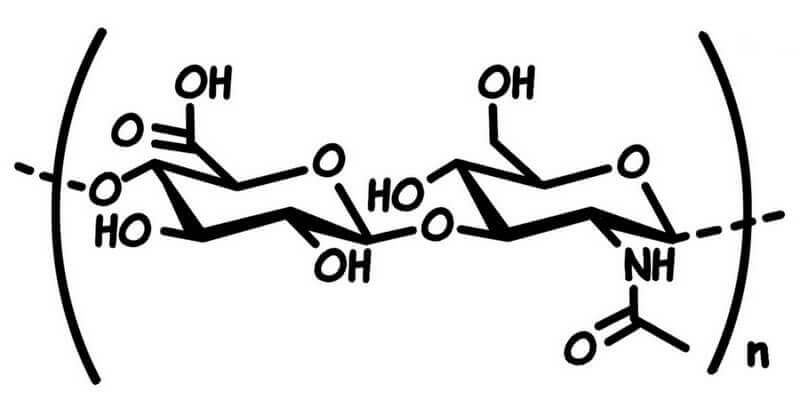
What exactly is hyaluronic acid?
While collagen and elastin are the main proteins that provide structural support for our skin, hyaluronic acid is like a gel-cushion that holds in moisture. This naturally occurring polysaccharide has the ability to absorb up to 1,000 times its weight in water, and when applied topically it can help skin hold in moisture and feel more supple. (1)
High molecular weight hyaluronic acid is also considered helpful for reducing inflammation and supporting tissue repair. (2) (3)
However, in the skincare world, low-molecular weight hyaluronic acid (LMW-HA) is often touted as superior because the smaller molecules are able to penetrate the skin’s surface. It’s made by breaking high molecular weight hyaluronic acid into fragments using enzymes.
So which one is better?
Low Molecular Vs. High Molecular Weight
While it’s true that low molecular weight hyaluronic acid does penetrate skin, it’s also well-documented in clinical research that low-molecular weight hyaluronic acid is actually pro-inflammatory rather than anti-inflammatory. (3)
Some doctors believe that while LMW-HA may make skin appear more supple at first, the effect may be due to inflammation rather than hydration, and could lead to accelerated aging. (4) It’s interesting to note that babies primarily make the high molecular weight form. (5)
Now, you might be thinking “What about high molecular weight hyaluronic acid – is it beneficial or similar to collagen . . . too large of a molecule for skin to absorb?”
In terms of topical benefits, it’s agreed that if nothing else, high molecular weight hyaluronic acid is an amazing moisturizer.
However, according to this study, full-size (high molecular weight) HA does actually penetrate skin.
Here’s what cosmetic chemist, Perry Romanowski, had to say on the subject.
Why is this so surprising? Two reasons. First, hyaluronic acid molecules are too big. They’re about 3,000 nm in diameter and the space between skin cells is only about 15 to 50 nm. Theoretically there’s no way a molecule that large should be able to make its way through the skin. Second, hyaluronic acid is very hydrophilic, or water loving, and we know that to penetrate skin substances have to be more oleophillic, or oil loving. (6)
And yet, according to the above study, it does. More research needs to be done, but it’s interesting.
Should I add essential oils?
You can add a 1% dilution (about 12 drops) of a skin-friendly essential oil such as lavender, frankincense, or helichrysum if you’d like.
However, I prefer not to because I apply the serum liberally around my eyes and it tends to run a bit. (Essential oils + Eyes = Not Good)
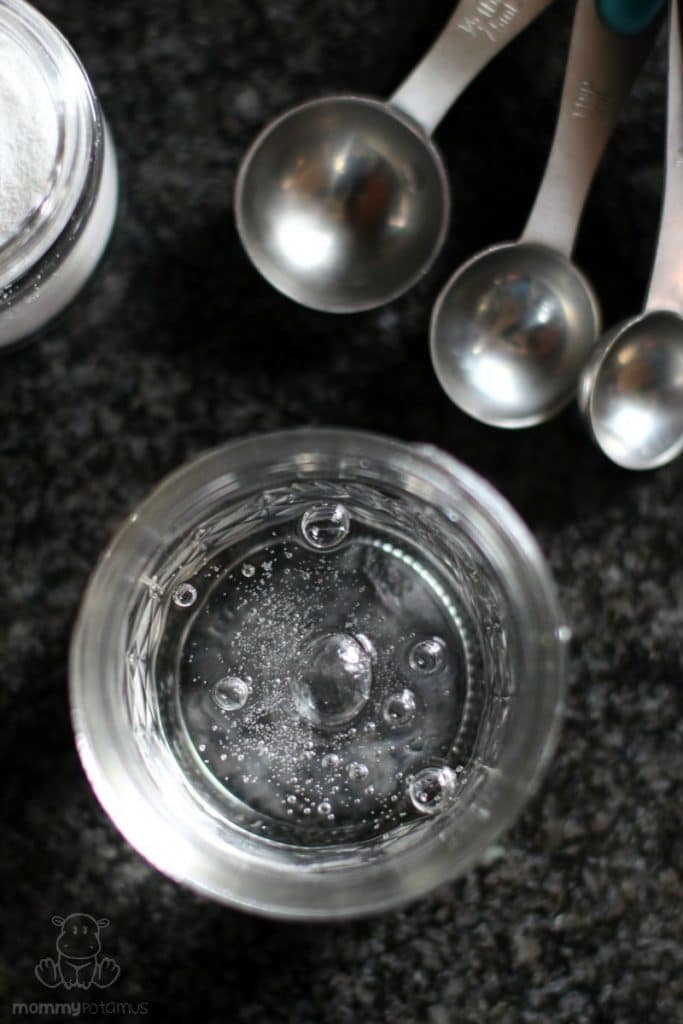
DIY Hyaluronic Acid Face Serum Recipe
Equipment
- small jar with lid
- measuring cup
- measuring spoon
Ingredients
- ¼ cup distilled water
- ½ tsp high molecular weight hyaluronic acid
- ¼ tsp glycerin (optional)
- ¼ tsp Leucidal Liquid SF preservative (optional)
Instructions
- Place powder in a small clean jar.
- Pour in distilled water and glycerin or leucidal if using.
- Place a lid on the jar and shake well. It will look very chunky at this point, but don’t worry. As the hyaluronic acid absorbs the water the consistency will become more smooth.
- Place in the fridge for several hours (or overnight) to allow it to thicken before use.
Notes
How To Use Your Hyaluronic Acid Serum
After washing your face with a gentle cleanser, pour or scoop a little bit the serum from a clean jar into your hands. Only a very thin layer should be applied – otherwise it will flake and peel off. It’s best not to dip your hands directly in the jar because it may reduce the shelf-life.
Ideally, this HA serum would be applied both in the morning and before bed. If you use skin toner, put it on after the toner and before moisturizer.
Important Tip: Hyaluronic acid is humectant, which means it draws moisture to itself. That’s part of what makes it amazing, but something to be aware of is that in dry climates where there isn’t much moisture in the air, it’s possible that hyaluronic acid could draw moisture from deeper layers of the skin upwards toward the surface.
To avoid this, I prefer to moisten my face and neck before applying hyaluronic acid. This way it has plenty of water to bind to. Then, after the serum dries I add a layer of this hydrating skin repair serum or my favorite store-bought tallow balm to seal in moisture.
FREE Ebook: DIY Body Care Gifts Made Simple
Do you want to give gorgeous, handcrafted gifts for family and friends, without spending a bunch of time on them?
Then I’d love to give you a free copy of DIY Body Care Gifts Made Simple – my step-by-step guide to making gorgeous skincare products without stressing yourself out – as a gift for signing up for my newsletter. I’ll show you how to make vintage labels, luxurious lotion bars, lip balms, sugar scrubs, body sprays and more like a pro. Sign up for my newsletter and you’ll be redirected to the download page immediately!
- Alina Maria Holban and Alexandru Mihai (2016) Nanoarchitectonics for Smart Delivery and Drug Targeting
- Litwiniuk, Malgorzata et. al. (2016) Hyaluronic Acid in Inflammation and Tissue Regeneration
- Ruppert, S.M. et. al. (2014) Tissue integrity signals communicated by high-molecular weight hyaluronan and the resolution of inflammation
- Dr. John Sanderson and Dr. George Taylor. Hyaluronic Acid: Yes, Size Does Matter
- Vinukonda, Govindaiah et. al. (2016) Hyaluronidase and Hyaluronan Oligosaccharides Promote Neurological Recovery after Intraventricular Hemorrhage
- Romanowski, Perry (2015) Is hyaluronic acid a good anti-aging ingredient?

